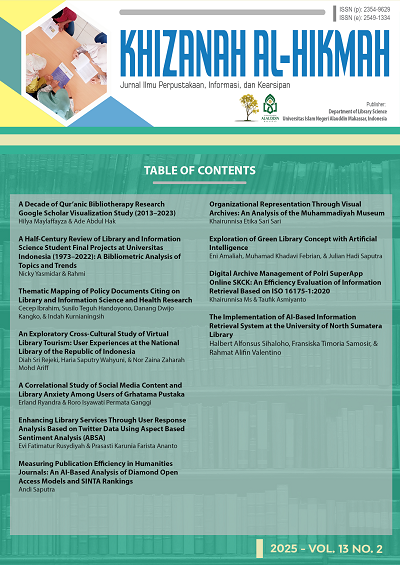A Correlational Study of Social Media Content and Library Anxiety Among Users of Grhatama Pustaka
DOI:
https://doi.org/10.24252/v13i2a5Keywords:
Library anxiety, Social media content, Instagram engagement, Library usersAbstract
This study investigates the influence of content from the Instagram account @balaiyanpus.dpaddiy on the level of library anxiety among patrons of Grhatama Pustaka. The primary objective is to determine whether exposure to this social media content is associated with variations in users’ library anxiety levels. The Croatian Library Anxiety Scale (CRO-LAS) was employed as the measurement framework for assessing library anxiety. A quantitative correlational method was used, with data collected through questionnaires distributed to 100 respondents who follow the Instagram account. Simple random sampling was applied to select participants. Descriptive analysis shows that all indicators fall within the “excellent” category. Results from the Pearson Product–Moment correlation test reveal a strong negative correlation between Instagram content and library anxiety, with a correlation coefficient of –0.706, indicating that more positive engagement with the account is associated with lower levels of library anxiety. Furthermore, the coefficient of determination shows that 49.9% of the variance in library anxiety levels can be explained by the content of the @balaiyanpus.dpaddiy Instagram account. These findings suggest that informative and supportive social media content can play a significant role in reducing library anxiety among users.
Downloads
References
Amarasekara, K. M. R. K., & Marasinghe, M. M. I. K. (2020). User Satisfaction on library resources and services: survey conducted in main library of the Open University of Sri Lanka. Journal of the University Librarians Association of Sri Lanka, 23(2), 27–46. https://doi.org/10.4038/jula.v23i2.8007
Borrego, Á., & Comalat Navarra, M. (2020). What users say about public libraries: an analysis of Google Maps reviews. Online Information Review, 45(1), 84–98. https://doi.org/10.1108/OIR-09-2019-0291
Bostick, S. L. (1992). The Development and Validation of the Library Anxiety Scale. Wayne State University.
Bouvier, G., & Machin, D. (2020). Critical Discourse Analysis and The Challenges and Opportunities of Social Media. Routledge.
Cheng, W. W. H., Lam, E. T. H., & Chiu, D. K. W. (2020). Social media as a platform in academic library marketing: A comparative study. The Journal of Academic Librarianship, 46(5), 102188. https://doi.org/10.1016/j.acalib.2020.102188
Creswell, J. W. (2016). Research design: pendekatan metode kualitatif, kuantitatif, dan campuran. Yogyakarta: Pustaka Pelajar.
Fatmawati, E. (2019). Kecemasan Pemustaka: Salah Satu Penyebab Rendahnya Tingkat Fisik Kunjungan ke Perpustakaan. Media Pustakawan, 26(1), 49–56. https://doi.org/https://doi.org/10.37014/medpus.v26i1.177
Gardijan, N. (2023). Library anxiety among Croatian students: Construction, Validation and Application of Croatian-Library Anxiety Scale (CRO-LAS). The Journal of Academic Librarianship, 49(3), 102687. https://doi.org/10.1016/j.acalib.2023.102687
Published
How to Cite
Issue
Section
License
Copyright (c) 2025 Erland Ryandra, Roro Isyawati Permata Ganggi

This work is licensed under a Creative Commons Attribution-NonCommercial-ShareAlike 4.0 International License.
By submitting your manuscript to our journal, you are following Copyright and License



